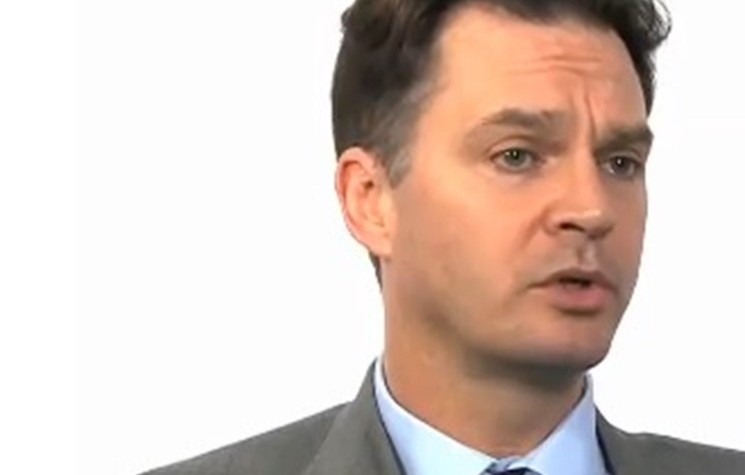George Ogilvie Has Got Kirkland Lake Gold Generating Cash Again, But $120 Million Of Debt Remains Outstanding

By Alastair Ford
It’s been an interesting 12 months for George Ogilvie. George was appointed chief executive of Kirkland Lake Gold back in December 2013, just as the gold price was bottoming out at US$1,200 per ounce after a precipitous fall from US$1,800.
That fall, following repeated delays to the planned expansion programme at the Kirkland Lake gold camp in Ontario, destroyed Kirkland’s margin, turning it loss-making at a stroke. The impact on the share price was immediate, and punishing.
“There was a 40 per cent fall off in the gold price”, says George, “and a share price fall of 90 per cent.”
Not exactly an auspicious environment to start a new job in. But George is no stranger to mining and the capital markets. For many years he ran Rambler Metals, a small listed copper company in Canada, taking it all the way from development concept to production, and riding a few swings in sentiment along the way.
This time his job is bigger, no mistake about that, but he hit the ground running and almost as soon as the ink was dry on his contract had put out revised production guidance.
That revision wasn’t exactly welcomed by the market, which cut the share price from over C$5.00 to less than C$3.00 but it did mark something of a watershed. From now on, Kirkland would not be shooting for the stars in its aspirations for expansion. Instead, both feet would be kept firmly on the ground. Guidance was going to be realistic, and under George’s watch it was going to be met.
The reasons why guidance hadn’t previously been met weren’t hard to find. There was the falling gold price. But there was more to it than that.
“Kirkland, like most mining companies in the gold sector, started on an expansion in the gold boom”, says George. “The plan was going to ramp up production from 50,000 ounces to 250,000 ounces. Production did hit 122,000 ounces, but the labour force went up five times and production was only up two and a half times.”
Costs were running ahead of cash flow. “In a falling gold price that was a recipe for disaster”, said George. “Every quarter there was a deficit of between C$15 million and C$20 million.”
And if production wasn’t, after all, going to 250,000 ounces, then there were only two other possible remedies. Grades were going to have to come up, and costs were going to have to come down.
Both, thought George, ought to be achievable. And he spent the rest of 2014 proving it.
First, there were the lay-offs. The once-mushrooming workforce was cut by 235 people to 1,015, and given that each worker was costing upwards of C$100,000, that allowed Kirkland to cut a tidy C$23 million from the cost base.
Then there was the grade. “What differentiates this mine is that the reserve grade, at 17.1 grams per metric tonne, makes it one of the highest grade projects in the world”, says George. “If we could get back to mining at the reserve grade we would really be making progress.”
And in the space of a short 12 months, George has already come a long way towards realising that aspiration. “We’ve increased head grade”, he says. “We now average 0.44 ounces per tonne or 15 grams per tonne.” Much of that increase is down to the opening up of new stopes on the 5,400 level of what is known as the South Mine Complex, a relatively new area of the Kirkland camp that apparently still has plenty of high grade ore to give.
The effects of the cost cutting and the renewed focus on grade have been marked. No longer is the company haemorrhaging cash, “It’s allowed us to drop all-in costs from C$1,500 per ounce to C$1,300”, says George. A handy start, especially since the company’s been selling gold lately at around C$1,400 an ounce.
The drive to bigger margins and greater profits will now centre on further cost savings, and more improvements to the grade.
“As we go forward the South Mine Complex will be a key area for us”, says George. “The previous management only had two levels on the go, mining reserves at 0.46 ounces per tonne. We’ve now started to get down to the 5,400 level and brought the first stopes into production last year. As we talk I’ve got three stopes in production, mining at 0.57 ounces. And there’s two additional stopes planned to come on line there between now and the end of the fiscal year.”
Meanwhile, down at the 5,600 level, the grade runs at a tidy 0.7 ounces per tonne. “Each time we go deeper the increase in cost is between two and three per cent”, says George, “but the increase in grade is 20-to-30 per cent.”
All told, this fiscal year the company plans to produce 150,000 ounces of gold, and to generate between C$7.5 million and C$10 million in free cash. Compared to how the business was looking a year ago, that’s a good result.
But it’s still quite tight. George expects further savings on Kirkland’s ground support contract, and on its explosives contract, which will help.
But it won’t be enough to address the issue of the C$120 million debt that is hanging over the company. These come in the form of two debentures, one for C$55 million and one for C$64 million. “The key focus for me this year has to be on addressing the balance sheet”, says George. “At the end of the day I can’t generate enough cash flow from operations to cover the whole debt. I have a plan, but I can’t really share it.”
Some form of refinancing is clearly in order. But we’ll have to wait and see exactly what George comes up with.

Comments (0)